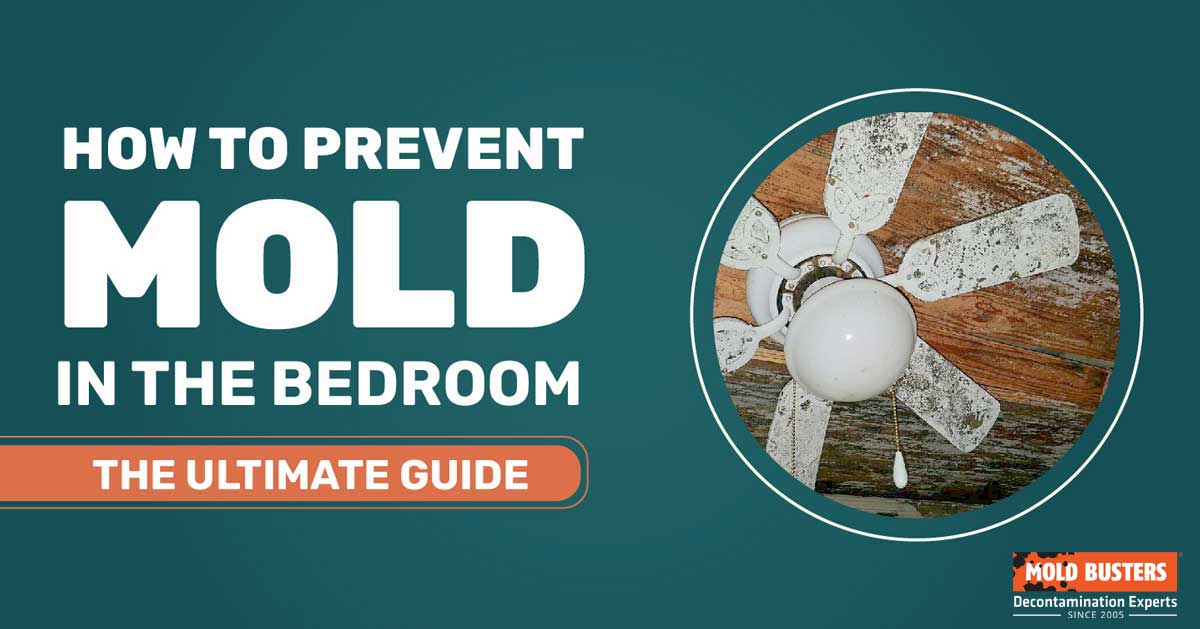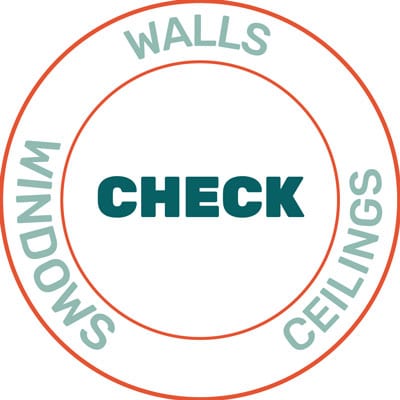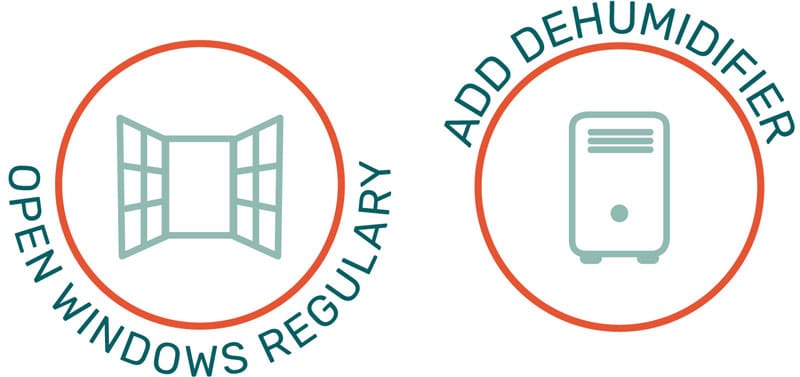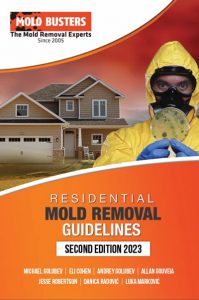How to Prevent Mold in the Bedroom
Preventing mold in bedrooms requires maintaining humidity below 50%, ensuring proper ventilation, and addressing moisture sources immediately. Since we spend 6-8 hours nightly in bedrooms, bedroom mold exposure poses significant health risks through prolonged inhalation of allergens and toxins.

Immediate Steps to Prevent Bedroom Mold (Under $50)
Preventing bedroom mold on a budget requires daily ventilation, proper furniture placement, and immediate moisture response. These cost-effective strategies work in any bedroom and require minimal investment while providing maximum protection against mold growth.
🛏️ Daily Prevention Habits
Establish a morning routine that includes 5-10 minutes of window ventilation, maintain 3-4 inch spacing between furniture and walls, and address any moisture within 24 hours. These simple habits cost nothing but dramatically reduce mold risk through improved air circulation and moisture control.
Morning ventilation routine: Open windows for 5-10 minutes each morning to exchange stale air and reduce overnight humidity buildup. This simple habit costs nothing but dramatically improves air circulation. For comprehensive mold prevention strategies throughout your home, apply similar ventilation principles in all rooms.
Furniture positioning: Keep furniture 3-4 inches from walls to allow airflow behind beds, dressers, and nightstands. This prevents moisture accumulation in dead air spaces where mold thrives. Similar spacing prevents mold on wood furniture and baseboards.
Immediate spill cleanup: Address any water spills, leaks, or wet clothing within 24-48 hours. Mold can begin growing in as little as 24 hours when moisture and organic materials combine. Understanding what causes mold growth helps prioritize response actions.
💡 Budget-Friendly Solutions ($10-50)
Affordable mold prevention tools include humidity monitors ($15-25), moisture absorbers ($10-20), exhaust fan timers ($20-40), and weather stripping ($15-30). These products provide measurable humidity control and moisture management without major renovation costs.
-
$15-25
Humidity monitors: Track bedroom humidity levels and maintain between 30-50% for optimal mold prevention. Learn more about professional humidity testing for baseline measurements.
-
$10-20
Moisture-absorbing products: Place silica gel packets or calcium chloride containers in closets and near windows
-
$20-40
Exhaust fan timers: Install programmable switches for existing bathroom fans to reduce humidity migration from bathroom areas
-
$15-30
Weather stripping: Seal gaps around windows and doors to prevent condensation and drafts, especially important for apartment mold prevention
Concerned About Mold in Your Bedroom? Get a Free Inspection!
Mold in the bedroom can be harmful, affecting your health while you sleep. Ensure your bedroom is safe with a free virtual mold inspection from Mold Busters. Our experts will provide a thorough assessment and actionable solutions to keep your home mold-free. Don’t wait, protect your health and home today!
Book Your Free Virtual Inspection NowWhy Bedrooms Develop Mold: Understanding the Causes
Unlike kitchens and bathrooms where steam creates obvious humidity, bedroom mold develops from subtle moisture sources that accumulate over time. Different types of mold prefer different conditions – understanding common mold types helps identify prevention priorities. The primary culprits include:
🌡️ Condensation from temperature differences: When warm indoor air meets cold windows, walls, or poorly insulated surfaces, condensation forms – creating perfect conditions for mold growth. This is particularly problematic for apartment dwellers with limited control over insulation.
😴 Human moisture production: During sleep, each person releases approximately 1–2 pints of moisture through breathing and perspiration, significantly raising bedroom humidity levels. Poor ventilation compounds this natural moisture source.
🚪 Poor ventilation and air circulation: Closed doors, windows, and inadequate airflow trap moisture and prevent natural drying, especially in corners and behind furniture. This creates conditions similar to those found in basement environments.
📍 If you’re in Montreal or Ottawa, our teams can help you assess and address these specific regional humidity challenges.

🔍 Bedroom Mold Inspection Checklist
Check windows and sills first, then walls behind furniture, ceilings near bathrooms, closets, carpets, and plant soil for visible growth, discoloration, or musty odors. Focus on areas with poor air circulation and external walls where condensation commonly occurs.
When checking for existing mold, focus on these high-risk areas in order of priority:
-
Windows and window sillsCheck for condensation stains, discoloration, or musty odors. Window mold is often the first visible sign of humidity problems.
-
🧱 Walls behind furnitureLook for dark spots, especially in corners and external walls. Similar patterns appear in wall mold situations throughout the home.
-
🚿 Ceilings near bathroomsInspect for water stains indicating moisture migration
-
🚪 Closets and storage areasCheck for dampness, especially in clothes and stored items
-
🧼 Carpets and flooringFeel for dampness and check for discoloration or unusual odors. Carpet mold requires immediate professional attention.
-
Plants and plant soilLook for white, gray, or green fuzzy growth on soil surfaces
🚨 If you discover suspicious growth, don’t panic. Contact professionals for proper mold testing and identification. Only laboratory testing can confirm mold type and determine appropriate remediation strategies. Learn about different black mold identification and white mold characteristics to understand what you’re observing.
🧪 Our Ottawa mold inspection and testing and Montreal mold inspection services provide comprehensive analysis and actionable solutions.
Seasonal Mold Prevention Strategies
Winter requires condensation control through insulation and heating management, while summer focuses on humidity reduction through dehumidifiers and air conditioning optimization. Seasonal strategies address temperature differentials and varying outdoor humidity levels that affect indoor mold risk.
Winter Prevention (November-March)
Combating CondensationPrimary challenge: Cold outdoor temperatures create significant temperature differentials with heated indoor air, leading to condensation on windows, walls, and cold surfaces.
Winter-specific solutions:
- • Storm windows or plastic film: Add insulation layers to reduce temperature differential
- • Heating system maintenance: Ensure proper humidity control through HVAC systems
- • Strategic ventilation: Brief ventilation periods during warmer daylight hours
- • Bedroom door management: Keep bedroom doors slightly open to prevent humidity buildup from other areas like kitchen activities
Summer Prevention (June-August)
Humidity ControlPrimary challenge: High outdoor humidity and air conditioning cycling can create moisture imbalances and poor air circulation.
Summer-specific solutions:
- • Air conditioning optimization: Maintain consistent temperatures rather than frequent on/off cycling. Check air conditioner mold prevention regularly.
- • Dehumidifier use: Target 45% humidity during high-humidity periods
- • Enhanced ventilation: Use ceiling fans to improve air circulation without raising temperatures
- • Moisture source elimination: Address landscaping, gutters, and external drainage issues that can affect basement and crawlspace humidity
Video: How to Prevent Mold in Bedroom
Advanced Mold Prevention Solutions ($50–200+)
Professional-grade mold prevention includes portable dehumidifiers ($80-200), HVAC humidity control systems ($150-500), exhaust fans ($50-150), HEPA air purifiers ($100-400), and ceiling fans ($75-250). These solutions provide mechanical moisture control and air circulation for comprehensive protection.
💧 Humidity Control Systems
Choose dehumidifiers rated for your bedroom square footage with built-in humidity controls and automatic drainage for continuous operation. Whole-house systems integrate with HVAC for comprehensive moisture management throughout the home.
🔄 Portable dehumidifiers
$80–200Choose units rated for your bedroom square footage. Look for models with built-in humidity controls and automatic drainage options for continuous operation.
🏠 HVAC humidity control
$150–500Whole-house dehumidifiers integrate with existing heating and cooling systems for comprehensive moisture management.
🧾 A regular humidity level test will determine whether basic ventilation suffices or if mechanical dehumidification is necessary for your specific climate conditions.
🌬️ Air Circulation Improvements
Install dedicated exhaust fans with timer controls, use HEPA air purifiers rated for mold spore removal, and add ceiling fans to prevent stagnant air pockets where moisture accumulates. Proper air circulation removes humid air and prevents mold-friendly conditions.
🛁 Exhaust fans
$50–150Install dedicated bedroom exhaust fans for homes without central air systems. Timer controls ensure consistent moisture removal.
🧼 Air purifiers with HEPA
$100–400Remove airborne mold spores while improving overall air quality. Choose units specifically rated for mold spore removal.
🔄 Ceiling fans
$75–250Improve air circulation year-round, helping prevent stagnant air pockets where moisture accumulates.
🔎 Check air vent mold prevention when installing new systems.
Apartment and Rental Property Solutions
Renters face unique challenges in mold prevention due to limited control over building systems and restrictions on permanent modifications. Focus on these tenant-friendly strategies:
🛠️ Non-Permanent Solutions
- 🌀 Portable equipment: Use dehumidifiers, air purifiers, and fans that can move with you
- 📝 Temporary insulation: Apply removable window films and draft stoppers
- 🪑 Furniture selection: Choose pieces that allow airflow and avoid upholstered items in high-humidity areas
- 📦 Storage strategies: Use moisture-resistant containers and avoid storing items directly on floors. Learn from garage mold prevention techniques for enclosed spaces.
📬 Landlord Communication
Document moisture issues with photos and humidity readings. Most jurisdictions require landlords to address mold problems that affect habitability. Know your tenant rights regarding:
- 🔧 Ventilation system maintenance
- 🚰 Leak repairs and water damage remediation
- 🌡️ HVAC system operation and humidity control
- 🏚️ Building envelope issues (windows, insulation, weatherproofing)
📍 For apartments in our service areas, contact Ottawa, Montreal, Gatineau, or other local offices for tenant-specific guidance.
Creating a Comprehensive Mold-Resistant Bedroom
Build mold resistance through optimized ventilation, strategic carpet management, proper furniture placement with 3-4 inch wall spacing, and regular HEPA cleaning to remove organic matter. Comprehensive protection requires addressing all moisture sources and airflow restrictions simultaneously.
💨 Ventilation optimization forms the foundation of effective mold prevention. Beyond morning window opening, create cross-ventilation patterns when possible. In humid climates like Florida, mechanical ventilation through dehumidifiers or air conditioning becomes essential when natural ventilation proves insufficient. Apply similar principles to whole-house mold prevention for comprehensive protection.
🧼 Carpet considerations: Wall-to-wall carpeting acts as a moisture and particle reservoir, potentially harboring mold spores even when appearing clean. If carpeting is necessary, ensure professional cleaning every 6–12 months and immediate attention to any water exposure. Preventing mold in carpets requires vigilant moisture control and regular maintenance.
🪑 Strategic furniture placement: Maintain 3–4 inches between furniture and walls, especially exterior walls prone to condensation. This spacing allows airflow that prevents moisture accumulation and makes cleaning more effective. Regular dusting and HEPA vacuuming remove organic matter that feeds mold growth. Consider similar spacing strategies for living room furniture to maintain consistency.

📊 For comprehensive analysis, consider our Montreal air quality testing and Ottawa air quality testing services for baseline measurements and improvement tracking.
Houseplant Management for Mold Prevention
While plants improve air quality in bedroom, they can harbor mold in soil and on leaves when not properly maintained. Mold in plant soil appears as grayish, white, or green fuzzy growth on the surface. Understanding different green mold types and white mold varieties helps identify plant-related issues early.
Plant maintenance protocol:
- Soil inspection: Check soil surface weekly for discoloration or fuzzy growth
- Proper watering: Water only when top inch of soil is dry; avoid overwatering that creates conditions similar to dishwasher mold environments
- Drainage optimization: Ensure pots have drainage holes and use saucers to protect surfaces
- Air circulation: Position plants away from walls and ensure adequate spacing between plants
- Soil treatment: Add natural antifungals like cinnamon or activated charcoal to soil
If mold appears on soil, remove affected soil immediately, improve drainage, and reduce watering frequency. For severe infestations, repot the plant entirely with fresh, sterile potting mix.

Did you know?
Only 11% of bedrooms we have tested didn’t have presence of mold?! Find out more exciting mold stats and facts inside our mold statistics page.
Comprehensive Closet Mold Prevention
🌫️ Closet mold prevention requires addressing the moisture-darkness combination that creates ideal growing conditions. Mold in closets affects both stored belongings and indoor air quality, with moldy clothing potentially causing direct skin contact reactions and health impacts.
👚 Clothing Storage Best Practices
☀️ Drying protocol:
Ensure complete drying before storage. Even slightly damp clothing can initiate mold growth in enclosed spaces. When possible, air-dry clothing outdoors to benefit from natural antifungal properties of sunlight and fresh air circulation.
🗃️ Seasonal storage management:
Before storing out-of-season clothing, provide extra drying time outdoors when weather permits. Use breathable storage containers or add ventilation holes to sealed containers. Include moisture-absorbing packets and natural insect deterrents like lavender sachets or cedar blocks.
🌀 Organization for airflow:
Avoid overpacking closets, which restricts air circulation. Maintain spacing between hanging clothes and ensure floor storage allows air movement underneath containers and boxes. Apply similar organization principles used in garage storage to prevent moisture accumulation.
🌡️ Closet Environmental Controls
💨 Ventilation improvements
Install battery-operated exhaust fans or ensure existing vents remain unobstructed. If natural ventilation exists, keep closet doors open periodically to exchange air with the main bedroom.
📉 Humidity monitoring
Place small humidity monitors in large closets to track moisture levels. Target humidity below 50% to prevent mold growth.
🔍 Regular inspection
Monthly closet inspections should include checking walls, ceilings, and floors for moisture signs, especially behind stored items and in corners where air circulation is minimal.

Professional Assessment and Remediation
When to Call Professionals
When prevention efforts fail and mold appears, professional assessment becomes essential. DIY treatment is appropriate only for surface mildew confirmed through professional testing.
For any visible growth, professional mold testing determines species and appropriate remediation strategies.
Professional remediation ensures complete spore removal and addresses underlying moisture sources that caused initial growth. Comprehensive mold removal includes containment, HEPA filtration, antimicrobial treatment, and moisture control solutions. Different approaches are required for various areas including attic remediation and black mold removal.
Our virtual inspection service provides convenient initial assessment, helping determine if immediate professional intervention is necessary or if enhanced prevention measures will suffice.
Health Protection During Sleep
Bedroom mold exposure occurs during the body’s most vulnerable state when respiratory defenses are naturally reduced during sleep. Prolonged mold exposure can cause respiratory irritation, allergic reactions, and sleep disruption, creating cascading health impacts.
Sleep quality protection
Maintain bedroom air quality through consistent prevention practices, as poor air quality directly impacts sleep quality and recovery. Consider air purification systems for individuals with existing respiratory sensitivities or allergies.
Early intervention benefits
Addressing mold growth within 24-48 hours prevents extensive contamination and potential health impacts. Quick response to moisture events and visible growth protects both property and occupant health.
For complex cases requiring professional intervention, our mold removal services ensure complete remediation while maintaining safe sleeping environments throughout the process.
Related Mold Prevention Resources
Room-specific prevention guides:
- 🚿 Prevent mold in bathroom – High-humidity area strategies
- 🍳 Prevent mold in kitchen – Steam and moisture management
- 🏚️ Prevent mold in basement – Below-grade moisture control
Professional services in your area:
Additional resources:
Frequently Asked Questions
Maintain bedroom humidity between 30-50% to prevent mold growth. Use a digital hygrometer to monitor levels and a dehumidifier when humidity exceeds 50%. Winter heating and summer air conditioning can affect these levels significantly. For accurate baseline measurements, consider our professional humidity testing services.
Natural mold prevention includes daily ventilation (5-10 minutes of open windows), proper furniture spacing (3-4 inches from walls), immediate moisture cleanup within 24 hours, and maintaining clean, dry conditions without chemical treatments. These methods work effectively in most climates, but humid regions may require additional mechanical assistance.
Bedroom mold grows due to condensation from temperature differences, human moisture production during sleep (1-2 pints per person nightly), poor ventilation that traps humidity, and organic materials that provide food sources for mold spores. Understanding these root causes helps target prevention efforts effectively.
Sleeping in a moldy bedroom poses health risks including respiratory irritation, allergic reactions, and sleep disruption. Professional assessment and remediation are recommended before continued occupancy, especially for sensitive individuals. Learn more about mold health effects and consider our virtual inspection service for immediate assessment.
Use a combination of immediate ventilation (open windows), dehumidifier operation, air circulation (fans), and moisture source elimination. For quick results, run a dehumidifier while ensuring adequate air circulation throughout the room. In severe cases, professional moisture control services may be necessary.
Look for signs like musty odors, visible growth on walls or ceilings, condensation on windows, and symptoms of mold exposure such as respiratory irritation or sleep disruption. Check behind furniture, in closets, and around windows where mold commonly develops. Professional mold inspection provides definitive identification.
Yes, professional removal is recommended for any visible mold growth larger than 10 square feet, or when health symptoms occur. Professional bedroom mold remediation ensures complete spore removal and addresses underlying moisture sources. DIY treatment is only appropriate for confirmed surface mildew after professional testing.

Get Special Gift: Industry-Standard Mold Removal Guidelines
Download the industry-standard guidelines that Mold Busters use in their own mold removal services, including news, tips and special offers:
"*" indicates required fields
Published: August 21, 2018 Updated: July 10, 2025

Written by:
John Ward
Account Executive
Mold Busters
Fact checked by:
Michael Golubev
CEO
Mold Busters
